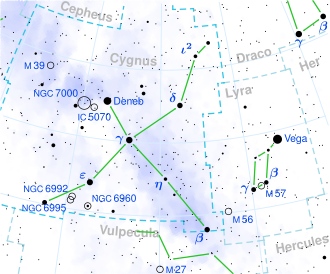NML Cygni
NML Cygni or V1489 Cygni is a red hypergiant star.[1] It is one of the brightest supergiant stars.[2] It was discovered in 1965, by Gerry Neugebauer, D.M. Martz and Robert Leighton.[3] The name 'NML' comes from the names of the three discoverers.[4]
NML Cygni's distance from Earth is about 5,250 light-years.[2] This star has dust surrounding it. It has a bean-shaped asymmetric nebula with water vapour.[5] It is a semiregular variable star. This means its brightness changes over 940 days.[6] Considering its distance and an upper limit on the star's angular size,[7] its physical radius must be less than 1,350 times that of the Sun.[8]
This star is a part of the Cygnus OB2 association, which is 1.74 ± 0.2 kpc away. This is one of the nearest massive star groups to the Sun.[6] This group includes some of the most massive and brightest stars known, including the suspected luminous blue variable Cyg OB2 #12. NML Cygni has lots of oxygen.[9] Molecules like H2O, Silicon monoxide, carbon monoxide, hydrogen cyanide, carbon monosulfide, sulfur monoxide, sulfur dioxide and hydrogen sulfide are also in the star.[3]
NML Cygni has two dense outer layers of dust and molecules. The star is also losing mass by slowly throwing gas into space.[3] The dust envelopes are formed by this process.[6]
NML Cygni Media
A near infrared (3.5 micron) light curve for V1489 Cygni, plotted from data published by Strecker (1975)
H-alpha light image of Cygnus OB2, the stellar association in which NML Cygni is located
References
- ↑ Zhang, B.; Reid, M. J.; Menten, K. M.; Zheng, X. W.; Brunthaler, A. (2012). "The distance and size of the red hypergiant NML Cygni from VLBA and VLA astrometry". Astronomy & Astrophysics. 544 (A42): A42. arXiv:1207.1850. Bibcode:2012A&A...544A..42Z. doi:10.1051/0004-6361/201219587. S2CID 55509287.
- ↑ 2.0 2.1 Schuster M.T. (2007). Investigating the circumstellar environments of the cool hypergiants. p. 57. ISBN 978-0-549-32782-0.
- ↑ 3.0 3.1 3.2 Marvel, Kevin (1996). "NML Cygni". The circumstellar environment of evolved stars as revealed by studies of circumstellar water masers. Universal-Publishers. pp. 182–212. ISBN 978-1-58112-061-5. Retrieved 23 August 2012.
- ↑ Hearnshaw J.B. (1996). "New infrared sources and their interpretation". The measurement of starlight: two centuries of astronomical photometry. Cambridge University Press. p. 278. ISBN 978-0-521-40393-1. Retrieved 23 August 2012.
- ↑ Schuster M.T; Humphreys R.M. & Marengo M. 2006. The circumstellar environments of NML Cygni and the cool hypergiants. The Astronomical Journal 131, 603. [1]
- ↑ 6.0 6.1 6.2 Schuster M.T. et al 2009. Imaging the cool hypergiant NML Cygni's dusty circumstellar envelope with adaptive optics. Astrophysical Journal 699 (2): 1423. [2]
- ↑ Richichi, A.; Percheron, I.; Khristoforova, M. (2005-02-01). "CHARM2: An updated Catalog of High Angular Resolution Measurements". Astronomy & Astrophysics. 431 (2): 773–777. Bibcode:2005A&A...431..773R. doi:10.1051/0004-6361:20042039. ISSN 0004-6361. Data about NML Cygni is found here at VizieR.
- ↑ Lang, Kenneth R. (2006). Astrophysical formulae. Astronomy and astrophysics library. Vol. 1 (3rd ed.). Berlin: Springer. ISBN 978-3-540-29692-8.. The radius (R*) is given by:
- [math]\displaystyle{ \begin{align} 2\cdot R_* & = \frac{(10^{-3}\cdot 1,610\cdot 7.8)\ \text{AU}}{0.0046491\ \text{AU}/R_{\bigodot}} \\ & 2,701\cdot R_{\bigodot} \end{align} }[/math]
- ↑ "Combined array for research in millimeter-wave astronomy" (PDF). Retrieved August 27, 2012.




